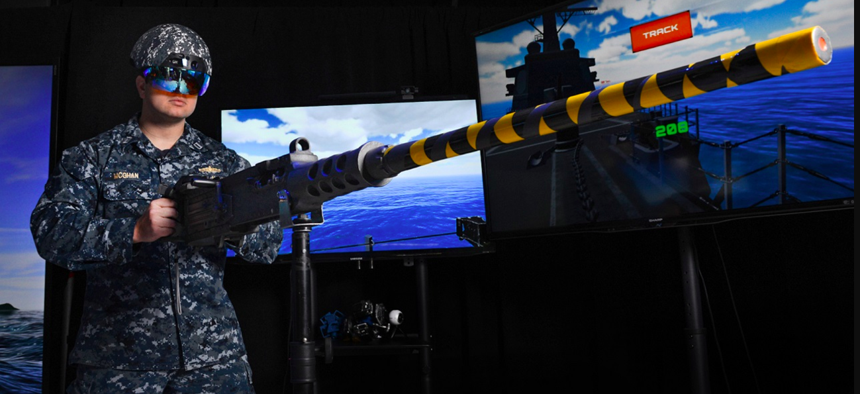
The Unified Gunnery System concept is an augmented reality (AR) helmet that fuses information from a ship's gunnery liaison officer and weapon system into an easy-to-interpret visual format for the gunner manning a naval gun system. Alan Antczak
US Navy Gunners Are Testing A Wearable Heads-Up Display
A service lab has turned a lieutenant’s brainstorm into a testable prototype dubbed the GunnAR augmented-reality headset.
In just a year, a wearable headset designed to help U.S. Navy gunnery sailors cut through the fog of combat has evolved from a lieutenant’s brainstorm to a prototype being tested in various exercises.
Conceived by a junior officer aboard the destroyer Gridley, the idea for GunnAR was presented at last year’s ONR Innovation Jam, where it received first prize — and $100,000 to make it real. After rapid progressions through various development milestones, the blue-tinted visor was put to the test in the Trident Warrior 2017 experiment aboard USS Bunker Hill, where sailors used it to put live fire on targets.
But what does GunnAR do, exactly? It is meant to facilitate communication between the ship’s gunnery liaison officer and the sailors manning the ship’s smaller guns. The headset is wirelessly connected to a tablet, which the officer uses to direct the gunner’s attention toward targets, and to start or stop firing. Cues and other information — infrared imagery, distances to targets — appear in a heads-up display projected on the visor. The system thus helps the sailor to see exactly what his or her officer wants him or her to do, all without having to rely on shouted orders, radio transmitters, or sound-powered telephones.
GunnAR is part of the military’s growing fascination with augmented and virtual reality. VR allows soldiers to train for battle without wasting expensive ammunition, while AR may eventually be used by commanders on the battlefield to pinpoint objectives and highlight threats to their troops. The Space and Naval Warfare Systems Center Pacific’s Battlespace Exploitation of Mixed Reality (BEMR) Lab, the outfit that made Lt. Robert McClenning’s idea a reality, frequently tests such technology.
In September, GunnAR will be part of in the CITADEL PROJECT waterside security experiment at Naval Base San Diego. In the year or so after, it is expected that DoD’s Physical Security Enterprise & Analysis Group will provide funding to produce and distribute the technology on a wider scale.



